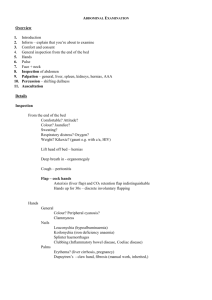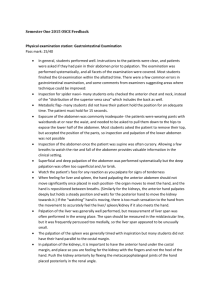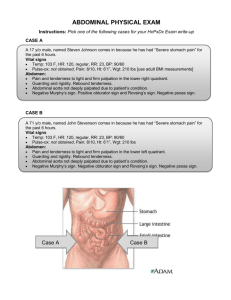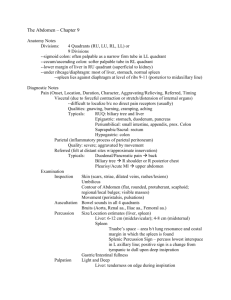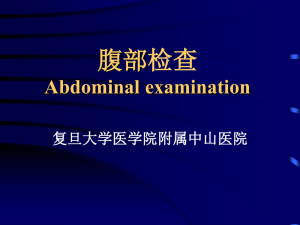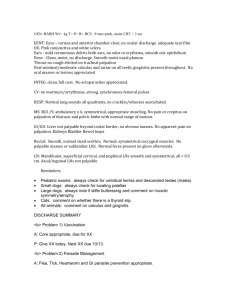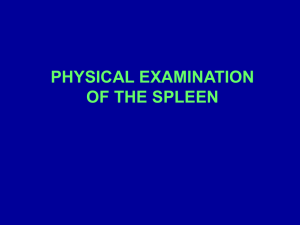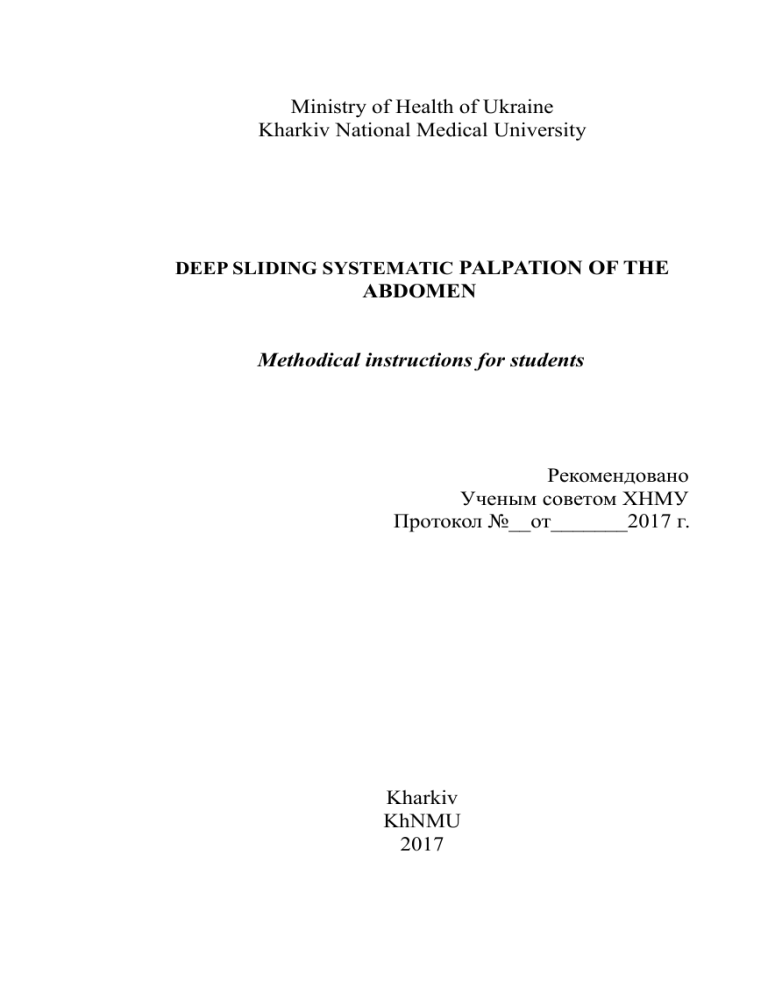
Ministry of Health of Ukraine Kharkiv National Medical University DEEP SLIDING SYSTEMATIC PALPATION OF THE ABDOMEN Methodical instructions for students Рекомендовано Ученым советом ХНМУ Протокол №__от_______2017 г. Kharkiv KhNMU 2017 Deep sliding systematic palpation of the abdomen: Меthod. instr. for students / Authors. Т.V. Ashcheulova, O.M. Kovalyova, G.V. Kozhemiaka – Kharkiv: KhNMU, 2017. – 20 p. Authors: Т.V. Ashcheulova O.M. Kovalyova G.V. Kozhemiaka Deep palpation can give you full information about the condition of the abdominal cavity and its organs, as well as their topography. Technique. The following sequence is recommended: 1. The sigmoid 2. The caecum with the appendix 3. The ascending colon 4. The descending colon 5. The transverse colon 6. The stomach 7. The liver 8. The pancreas 9. The spleen 10. The kidneys The palpation technique includes following steps: 1. Proper position of your hands. Place the right hand flat on the anterior abdominal wall, perpendicular to the axis of the examined organ; 2. Form a skin fold to facilitate further movements of the examined hand; 3. Move your fingers gradually with each expiration into abdomen, when the abdominal wall is relaxed. Your hand thus reaches the posterior wall of the abdomen or the underlying organ; 4. Last step: sliding movement of your fingertips in the direction perpendicular to the transverse axis of the examined organ. In deep palpation you should assess location, diameter, density, the condition of surface (smooth, tubercular), tenderness, mobility, and presence or absence of rumbling sounds of examined organ (Tab.1). Tab.1. Deep sliding systematic palpation I. Sigmoid - palpable - impalpable If palpable, to indicate: 1. Location - left iliac region at the border of median and outer third of the linea umbilico-iliacae - deviation from these points 2. Diameter - 2-3 cm 3. Density 4. Surface 5. Tenderness 6. Mobility 7. Rumbling sounds II. Caecum If palpable to indicate: 1. Location 2. Diameter 3. Density 4. Surface 5. Tenderness 6. Mobility - thin cylinder thick cylinder (>3 cm) different diameter moderate density dense consistency, firm paste-like consistency plane, smooth rough, tubercular painful painless 3-5 cm limited mobility immobile significant mobility floating sigmoid absent present palpable impalpable - in the right iliac region at the border of median and outer third of the linea umbilico-iliacae deviation from these points 3-4 cm thick thin different diameter soft dense, firm plane, smooth tubercular painless painful 2-3 cm limited mobility immobile - - significant mobility - floating caecum 7. Rumbling sounds - present - slightly rumbles - loudly rumbles III. Ascending and - palpable descending colons - impalpable If palpable, to indicate diameter, density, tenderness, mobility, presence of the rumbling sound, and assess surface. IV. Transverse colon - palpable - impalpable If palpable to indicate: 1. Location - in male – at the umbilicus level, 1cm lower umbilicus - in female – 1-3 cm lower umbilicus 2. Diameter - 2-2,5 cm 3. Surface - plane, smooth - rough 4. Tenderness - painless - painful 5. Rumbling sounds - absent - present V. Stomach (the greater - palpable curvature) - impalpable If palpable to indicate: 1. Location - in male – 3-4 cm above umbilicus - in female – 1-2 cm above umbilicus - changed location of the greater curvature level 2. Consistency - soft, thin fold - dense cylinder 3. Rumbling sounds - absent - present VI. Liver Anterior axillary line Midclavicular line Right parasternal line Anterior median line - palpable at the costal arch palpable …cm below the costal arch impalpable palpable at the costal arch palpable …cm below costal arch impalpable palpable 2 cm below costal arch impalpable at the level of upper third of distance between xiphoid process and umbilicus impalpable If the liver is palpable, to discribe: 1. lower edge - rounded - serrated - sharp - dull 2. surface - smooth - tubercular 3. consistency - moderate density - soft - firm 4. tenderness - painless - painful VI. Gall bladder - impalpable - palpable If palpable, to indicate size, shape, consistency, tenderness, mobility VIII. Pancreas - impalpable - palpable If palpable, to determine: 1. Location - 4-5 cm upper umbilicus - other variants 2. Consistency - dense cylinder 1-2 cm in diameter - other variants 3. Tenderness IX. Spleen Percussion: a) the spleen diameter b) the spleen length Palpation If palpable, to determine: 1. Location - painless painful - 4-6 cm more than 6 cm 6-8 cm more than 8 cm - impalpable palpable - palpable 1 cm below costal arch middle of the distance between umbilicus and left costal arch reaches median line (occupies left part of the abdominal cavity) the spleen get to the right part of the abdominal cavity and in the pelvic region soft dense firm painless painful smooth rough tubercular 2. Consistency 3. Tenderness 4. Surface - The sigmoid. Place four fingers of the right hand together and slightly flexed perpendicularly to the axis of intestine, which runs obliquely in the left iliac region at the border of median and outer third of the lineaimbilico-iliacae (Fig.1). As soon as posterior wall of the abdomen is reached, the fingers slide along intestine laterally and downward, and later the sigmoid slips from under the examining fingers. The sigmoid can be palpated in 90-95 % cases; normally over the length of 20-25 cm as a smooth firm cylinder, 2-3 cm in diameter, painless, easily displaces 3-5 cm to either side, doesn't rumble, with weak and rare peristalsis. Fig. 1. Palpation of the sigmoid. The caecum. Place your right hand along right umbilico-iliac line, the technique of palpation is the same. Fig.2. Palpation of the caecum. The caecum is situated at the border of the median and lateral third of the umbilico-iliac line (5 cm by the iliac spine). It can be palpated in 80-85 % of cases as a smooth, soft, elastic, slightly enwided downward cylinder, 3-4 cm in diameter, painless, moderate mobile (passive mobility to 2-3 cm); when pressed upon, it rumbles. The vermiform process (appendix) can be found in 20-25% of cases above or below the terminal and of the caecum (ileum) in a form of thin, painless cylinder. During palpation appendix doesn't change consistency and doesn't rumble. The ascending and descending colons are palpated by two hands. The left hand is placed under the right (Fig. 2.3.9) and then the left (Fig. 2.3.10) lumbar region, while the finger of the right hand press on the anterior wall of the abdominal cavity until you feel your right and left hands meet. Fig.3. Palpation of the ascending colon. The fingers then slide laterally, perpendicularly to the axis of the intestine. Ascending and descending colons are palpated, accordingly, in the right and in the left lateral flanks in a form of mobile, moderate dense, painless cylinder near 2 cm in diameter. Fig. 4. Palpation of the descending colon. The transverse colon is palpated or by one hand or bimanual palpation is used (Fig.4). The right hand (or both hands) you should place on the sides of the lineaalba and the skin more slightly upwards. When immerse your hands gradually during relaxation of the prelum out expiration until the posterior wall of the abdomen is felt. Once the posterior wall is reached, the examining hand should slide down to feel the intestine. Fig. 5. Palpation of the transverse colon. Normal transverse colon can be palpated in 60-70 % of cases, this is an arching cylinder, of moderate density, near 2,5 cm in diameter, pain less, cagily movable up and down and silent. The stomach. Pull up the skin on the abdomen and press carefully to penetrate the depth until the fingers reach the posterior wall, the stomach slips from under your fingers. The greater curvature can best of all examined by this method in 50-60% of healthy subjects; the lesser curvature can be palpated in gastroptosis. The greater curvature is found to either side of the median line 3-4 cm above the umbilicus in male, and 1-2 cm in female in a form of smooth, soft, not mobile, and painless ridge. The liver. Because most of the liver is sheltered by the rib cage, assessing it is difficult. However, its lower edge, surface, consistency, and tenderness can be estimated by palpation. You should remember that respiratory mobility of the liver is highest compared with other abdominal organs because the liver is closest to the diaphragm. Therefore, during palpation the active role belong to the liver respiratory mobility rather than to your palpating fingers. Sit by the right side, facing the patient. Place four fingers of your left hand behind patient, parallel to and supporting the right 11th and 12th ribs, use left thumb to press on the costal arch to move the liver closer to the palpating fingers, and to prevent expansion of the chest during inspiration. This stimulates greater excursions of the right cupola of the diaphragm. Place your right hand flat on the patient’s right abdomen lateral to the rectus muscle (in midclavicular line), with your fingertips well below the costal arch. Press gently in and up. Then ask the patient to take deep breath; the liver descends to touch the palpating fingers and then slides to bypass them. Your right hand remains motionless. The procedure is repeated several times. Try to feel the liver edge as it comes to meet your fingers. If you feel it, note surface, consistency, and any tenderness of the liver lower edge. The normal liver can be palpated in 88 % of cases. On inspiration, the liver below is palpable about 1-2 cm below the right costal margin in the midclavicular line. The edge of the normal liver is soft, sharp, tenderness, its surface is smooth. Fig. 6. Palpation of the liver. The pancreas. Because of the deep location and soft consistency of the gland, palpation of the pancreas is very difficult. The normal pancreas can only be palpated in 4-5% of female and 1-2% of male with cachexia, relaxed prelum and ptosis of internal organs. The pancreas should be palpated in the morning, with empty stomach. Place your right hand horizontally, 2-3 cm above the preliminary found lower edge of the stomach. Pull the skin upward and then press gradually right hand into abdominal cavity with each expiration. When you reach posterior wall, slide your hand downward. A normal pancreas is soft transverse cylinder, 1,5-3 cm in diameter, immobile, and tenderness. The spleen. The patient should lie on his right side, his head should be slightly down on a small pillow, the left elbow bent an resting freely on the chest, the right leg should stretched and the left leg flexed at hip and knee (Fig. 2.3.13). Fig. 7. Palpation of the spleen. In this position the prelum is relaxed to a maximum, and gravity may bring the spleen forward and to the right into a palpable location. Sit on the right side, facing the patient. Place your left hand on the left part of the chest between 7th and 10th ribs in the axillary lines and slightly press to limit respiratory movements. With your right hand below the left costal margin, at the point of junction of the costal arch and the 10th rib, press gradually during expiration in toward the spleen. Ask the patient to take deep breath (Fig. 2.7). If the spleen is palpable, it is displaced during inspiration by the descending diaphragm to meet your fingers and to slip over them. Fig. 8. Inspiratory movement of the spleen. Try to feel the tip or edge of the spleen, note location, consistency, any tenderness, and surface. A normal spleen is impalpable. In a small percentage of normal adults, the tip of the spleen is palpable. Causes include a low, flat diaphragm, as in chronic obstructive pulmonary disease, and a deep inspiratory descent of the diaphragm. Test control 1. The patient, 39 years, complains of frequent liquid excrements (till 10-12 time on times) with an impurity of slime and blood, decrease in body weight of 4 kg for last year. Marks itself ill about one year. Repeatedly inspected in the infectious hospital where diagnoses of sharp infectious diseases have been removed. At inspection: patient is sharply lowered fatness, skin is flabby, dry. The abdomen is soft, palpation in left iliac region is sharply painful. In excrements insignificant amount of rare contents with an impurity of blood. What organ defeat is it possible to think of ? A. Stomach B. Sigmoid colon C. Liver D. Transversus colon E. Cecum 2. Patient Р. 66 years Disturbs the heavy feeling in the epigastral region, disgust for meat food, decrease in body weight. In the anamnesis atrophyc gastritis. Inspection: pallor skin, expressed weight loss, the dense lymph node is palpable above left clavicular. Detonation of a abdomen wall in epigastral region. Blunt painess is define in epigastral region during palpation. Percussion - big curvature of the stomach is below the umbilicus about 2 sm. Your previous diagnosis? A. Pilorostenosis B. Bleeding C. Cancer of the stomach D. Atrophic gastritis E. Ulcer of the stomach 3. Patient D. 50 years has arrived with complaints on heavy and sensation of completeness in epigastral region that amplify after food, an eructation rotten, and also the food eaten on the eve. The simplification comes after vomiting. In the anamnesis - a stomach duodenal ulcer during 10 years.For last month has weight loss about 3 kg.Inspection. The lowered feed}, dry skin, cheilitis, tongue is covered by white patch. Superficial palpation of the abdomen: the abdomen is a little swell, painful in epigastral region is determine. Percussion of the abdomen: «splashing » noise above epigastral region, the lower border of the stomach is on 2-3 sm below umbilicus. What complication of a stomach ulcer has arisen in the patient? A. Penetration B. Pilorostenosis C.Perforation D. Bleeding E.Malignization 4. The patient, 45 yeasr has in anamnesis the stomach ulcer, has suddenly felt „knife-like» pain in epigastral region that irradiates to wright scapula, and then extended in the right half of the abdomen. The pain has accompanied by reusable vomiting. Inspection: position of the patient laying with knees led to the trunk, breath is superficial, features are aggravated. Palpation of the abdomen - plank-buttress.Percussion of the lateral region - dullness.Shchetkin-Blumberg symptom is positive. Your diagnosis? A. Perforatsion B. Penetration C. Malignization D. Bleeding E. Pylorostenosis 5. The patient, 30 years delivered to the admition dep. with complaints of the general weakness, fainting, palpitation. The anamnesis. The heartburn during one year that arises just after the meal, especially sour or sharp, that accompanies by epigastral pain. Becomes ill sharply when suddenly has quickly lost consciousness (works on construction). Inspection.Pale skin, АP-80/50 Hg, pulse - 120 per minute, weak filling and a pressure. Tones of the heart are weakened, rhythmic, systolic noise on the top. Palpation of the abdomen – moderate painess in the epigastrium Abdomen is soft, symptoms of peritoneum irritation are absent. Your previous diagnosis? A. Perforatsion B. Penetration C. Malignization D. Bleeding E. Pylorostenosis 6. The patient, 33 years, has arrived in surgical branch with complaints of the pain in right side of the abdomen. Hurt occurrence he connects with the use of sharp and rough food. Pain in the right iliac region has been revealed during palpation and percussion. Your previous diagnosis? A.Acutecholecystitis B. Acute gastritis C. Acute appendicites D. Stomach ulcer E. Enterocolitis 7. The patient, 22 years, has arrived in surgical branch with complaints of intensive pain in right side. Painful palpation of the abdomen in right iliac region, painful palpation of Mac-Burneus point.Your previous diagnosis? A. Acute cholecystitis B. Acute gastritis C. Acute appendicitis D. Stomach ulcer E. Enterocolitis 8. The patient, 76 years, complains of constants constipation, a swelling of the abdomen, a periodic pain in the left side. At the palpation - sigmoid colon is dense, painful, its surface unequal, hilly. Your previous diagnosis? A. Sigmoiditis B. Colitis C. Dysentery D. A malignant new growth E.Plenty gases accumulation 9. The patient, 78 years, complains of a pain in the left side. In the anamnesis - constopation during many years. Last defecation was 1 week ago. At palpation the blind gut is considerably increased at the rate, dense, painful, does not hum, with a corpulent surface. Your previous diagnosis? A. Appenditsitis B. Plenty cal mass accumulation S. Tuberkulesis D. A malignant new growth E. Plenty gases accumulation 10. « noise of splash » at healthy personse is determine: A. Just after food B. In 1-3 hours after food C. In 3-5 hours after food D. In 5-7 hours after food E. In 7-10 hoursafterfood Keys: 1В, 2С, 3В, 4А, 5D, 6С, 7С, 8D, 9В, 10А. Methodical instructions Deep sliding systematic palpation of the abdomen Methodical instructions for students Authors: Т.V. Ashcheulova O. M. Kovalyova G.V. Kozhemiaka Chief Editor Ashcheulova Т.V. Редактор____________ Корректор____________ Компьютерная верстка_____________ Пр. Ленина, г. Харьков, 4, ХНМУ, 61022 Редакционно-издательский отдел
